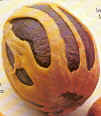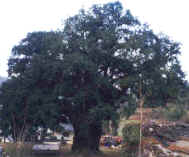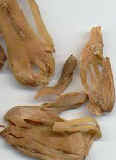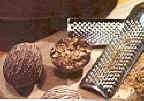|
Nutmeg and Mace
Â
Information about Nutmeg and Mace plus Nutmeg and
Mace Recipes
Â
Â
Â
Â
 The
nutmeg tree
(Myristica Fragrans)
is unusual in that it produces a fruit, the pericarp of which encloses two
distinct spices: nutmeg from
the seed itself and mace from the aril covering the seed. By the way, the "mace" used inÂ
crowd control and aerosols to deter would-be attackers is a chemical and
has nothing to do with this plant.
 The
nutmeg tree
(Myristica Fragrans)
is unusual in that it produces a fruit, the pericarp of which encloses two
distinct spices: nutmeg from
the seed itself and mace from the aril covering the seed. By the way, the "mace" used inÂ
crowd control and aerosols to deter would-be attackers is a chemical and
has nothing to do with this plant.
Â
Origins and History
of Nutmeg and Mace
Their first specific place of origin was in the Banda Islands,
Indonesia. Dutch explorers, in particular Van den Broeke and Jan Pieterscoon
Coen took away the first batch of nutmegs from there in 1608. Their spread and
popularity in Europe was meteoric.
 So prized were these spices, that by
1621, Dutch military forces invaded and conquered the Banda Islands in order to
gain physical control and have a monopoly over
the production and trade of nutmeg and mace and consequently be able keep the
prices extremely high in Europe. However the higher price paid was by the
indigenous people of the islands, most of whom (some estimates say 90%)Â
were killed or enslaved during the invasion. So prized were these spices, that by
1621, Dutch military forces invaded and conquered the Banda Islands in order to
gain physical control and have a monopoly over
the production and trade of nutmeg and mace and consequently be able keep the
prices extremely high in Europe. However the higher price paid was by the
indigenous people of the islands, most of whom (some estimates say 90%)Â
were killed or enslaved during the invasion.
Both
spices were still extremely popular in England and throughout Europe in theÂ
18th and 19th centuries. The English word nutmeg
comes from the latin nux,
meaning nut, and muscat, meaning
musky.Â
However, Nutmeg was also known
to the ancient world. It has been found in Egyptian tombs and around the 13th
century the Arabs began to trade it in the Middle East and Mediterranean.
Cultivation
and Processing
Nutmeg and Mace
The trees are currently
cultivated
principally in the Moluccas and the West Indies and elsewhere with varying
success.
 These
splendid evergreen �fruit� trees are big, reaching a height of about 65 feet (20
metres). They start bearing
fruit 8 years after sowing, and continue to bear for 60 years or longer.Â
When the fruit fully matures, it
splits in two, exposing a crimson- coloured aril, the mace, surrounding a single
brown seed, the nutmeg.
 These
splendid evergreen �fruit� trees are big, reaching a height of about 65 feet (20
metres). They start bearing
fruit 8 years after sowing, and continue to bear for 60 years or longer.Â
When the fruit fully matures, it
splits in two, exposing a crimson- coloured aril, the mace, surrounding a single
brown seed, the nutmeg.
Â
In the processing of mace, the crimson-coloured
aril is removed from the nutmeg, flattened out and dried for 10 to 14 days.
During this time its colour changes to pale yellow, orange, or tan. Whole dry
mace consist of flat pieces which are smooth,
horny, and brittle which about 4cm/1.5 inches long (blades).
The remaining fruit are also dried gradually in
the sun and turned twice daily over a period of six to eight weeks. Once dried,
the shell is then broken and the nutmegs removed. These are greyish-brown ovals
with furrowed surfaces and measure about 3cm/1-1/4Â inches
long with a diameter of 2.5cm/ 1 inch.
|

 The
nutmeg tree
The
nutmeg tree So prized were these spices, that by
So prized were these spices, that by These
splendid evergreen �fruit� trees are big, reaching
These
splendid evergreen �fruit� trees are big, reaching T
T Nutmeg has a more robust flavour
Nutmeg has a more robust flavour